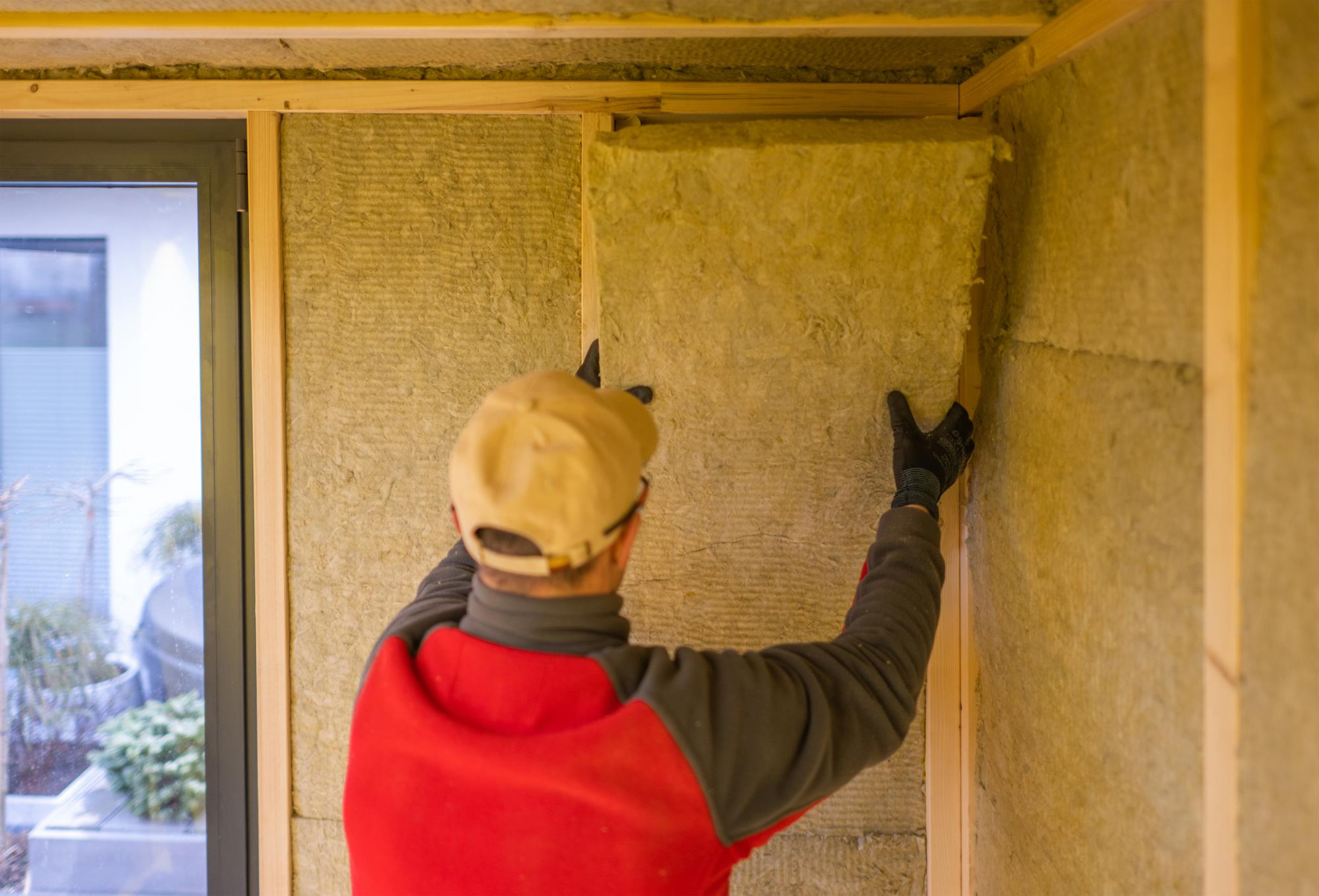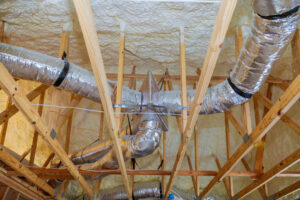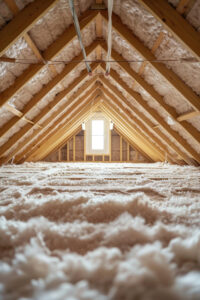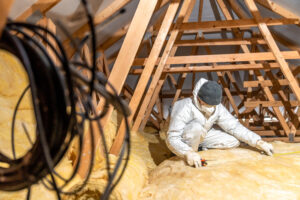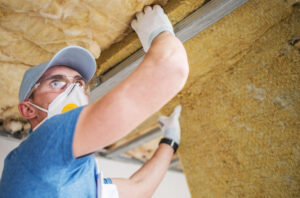The best non-toxic insulation options for attics include mineral wool, cellulose, cork, hemp, and sheep’s wool, which offer excellent insulating properties without harmful chemicals.
When it comes to making our homes healthier, the insulation in our attics deserves special attention. Many traditional insulation materials contain chemicals that can affect indoor air quality and potentially our health.
These safer alternatives not only protect our families from potential toxins but also perform well in keeping homes comfortable. Mineral wool stands out for its mold resistance, making it ideal for attic spaces where moisture can sometimes be an issue. Cellulose, made from recycled paper products, offers good insulation value while being an eco-friendly choice.
We believe choosing the right insulation is about balancing performance, safety, and environmental impact.
Each non-toxic option has its own strengths – cork provides natural fire resistance, sheep’s wool regulates humidity naturally, and hemp offers excellent thermal performance. By selecting one of these healthier materials, we can create attic spaces that contribute to both energy efficiency and better indoor air quality.
In this guide, you’ll learn which non-toxic materials offer the best balance of performance, health protection, and environmental impact, so you can make an informed decision for a healthier, more efficient home.
Here’s what you need to know:
- Understanding non-toxic attic insulation
- Types of non-toxic insulation materials for attics
- Performance, safety, and environmental considerations
- Maximizing attic health and efficiency with proper installation
Good reading!
Understanding non-toxic attic insulation
Choosing the right insulation materials for your attic impacts both your home’s energy efficiency and your family’s health. Non-toxic options provide effective insulation without introducing harmful chemicals into your living space.
Why choosing the right insulation material matters
The insulation in our attics plays a crucial role in maintaining home comfort and energy efficiency. But not all insulation materials are created equal when it comes to safety. Traditional insulation options may contain chemicals that can off-gas into our living spaces for years.
When we select attic insulation, we’re making a decision that affects our indoor air quality. Since air naturally circulates between our attic and living spaces, toxins released from insulation can find their way into the air we breathe daily.
The Consumer Product Safety Commission has identified certain insulation materials as potential sources of indoor air pollution. This makes our choice of insulation material not just about thermal performance, but about creating a healthier home environment.
Health and environmental benefits of non-toxic insulation
Non-toxic attic insulation provides excellent thermal performance while safeguarding our health. These materials help maintain consistent indoor temperatures without introducing harmful chemicals into our homes.
Health Benefits:
- Improved indoor air quality
- Reduced respiratory irritation
- Fewer chemical sensitivities
- Better sleep quality
Environmental Advantages:
- Many options are made from renewable resources
- Lower carbon footprint
- Often recyclable at end of life
Hemp insulation stands out as a particularly promising option. It’s naturally resistant to mold and pests, doesn’t irritate skin during installation, and offers excellent thermal performance.
Other eco-friendly choices include wool, cellulose, and cotton insulation. These materials can effectively regulate temperature and humidity while being safer for installation and long-term exposure.
Common toxins and health concerns in traditional insulation
Many conventional insulation types contain chemicals that may affect our health. Fiberglass insulation, while common, can release tiny glass particles that irritate skin and lungs during installation and potentially afterward.
Harmful substances in traditional insulation include:
- Formaldehyde (found in many fiberglass and foam products)
- Flame retardants (linked to endocrine disruption)
- Volatile Organic Compounds (VOCs)
- Chemical binders and adhesives
These toxins can trigger respiratory issues, skin irritation, and headaches. Long-term exposure to formaldehyde, classified as a probable human carcinogen, is particularly concerning.
People with allergies, asthma, or chemical sensitivities may experience more severe reactions to these substances. Children and elderly individuals tend to be more vulnerable to these indoor pollutants.
According to the Environmental Working Group (EWG), selecting insulation materials certified by GREENGUARD ensures low emissions of volatile organic compounds (VOCs), contributing to healthier indoor air quality. This makes certification an important factor when evaluating insulation safety, not just the base material.
Types of non-toxic insulation materials for attics
When selecting non-toxic insulation for your attic, several excellent options provide effective thermal performance without harmful chemicals. These natural and recycled materials offer various benefits including fire resistance, moisture management, and sustainability.
Cellulose insulation
Cellulose insulation is made primarily from recycled paper products, typically newspapers. It’s treated with non-toxic borate compounds that make it fire-resistant and pest-resistant.
With an R-value of 3.2-3.8 per inch, cellulose provides excellent thermal performance. It’s also one of the most affordable non-toxic options available.
Cellulose excels at filling irregular spaces and can be blown into existing walls and attics without major renovation. This makes it ideal for retrofit projects.
One concern with cellulose is its tendency to settle over time, which may reduce its effectiveness. It can also absorb moisture if exposed to leaks, so proper moisture barriers are essential.
Mineral mool insulation
Mineral wool (also called rock wool) is made from natural stone and recycled slag from steel mills. It contains no formaldehyde or other harmful chemicals commonly found in conventional insulation.
It offers exceptional fire resistance, withstanding temperatures up to 1,800°F. This makes it one of the safest insulation options available.
With an R-value of 3.0-3.3 per inch, mineral wool provides reliable thermal performance. It’s also naturally water-repellent and won’t promote mold growth.
Mineral wool is dense and rigid, making it excellent for sound dampening between floors. It’s available in batts, boards, and loose-fill forms for different applications.
Sheep’s wool insulation
Natural sheep’s wool insulation offers impressive performance with no toxic components. The wool is washed and treated with borate for fire resistance and pest protection.
Wool has a unique ability to absorb and release moisture without compromising its insulating properties. It can absorb up to 30% of its weight in water without feeling wet.
With an R-value of about 3.5-3.8 per inch, wool performs comparably to conventional materials. It’s also naturally flame-resistant and can actually help purify indoor air by absorbing pollutants.
The main drawback of wool insulation is its higher cost compared to other options. However, its durability and performance often justify the investment for health-conscious homeowners.
Hemp insulation
Hemp insulation is made from the woody core of the hemp plant mixed with polyester binding fibers. It’s rapidly renewable and requires minimal processing.
Hemp has an R-value of approximately 3.5 per inch, comparable to fiberglass but without the health risks. It’s naturally resistant to mold, pests, and fire.
This material can absorb and release moisture, helping to regulate humidity levels in your attic. This property helps prevent condensation and moisture problems.
Hemp insulation is biodegradable and can be composted at the end of its useful life. While not as widely available as other options, its popularity is growing as more people seek sustainable building materials.
Performance, safety, and environmental considerations
When selecting non-toxic insulation, we need to look beyond just avoiding harmful chemicals. The ideal insulation should perform well thermally, resist fire, handle moisture properly, and contribute to better indoor air quality.
Thermal resistance and R-value
R-value measures how well insulation resists heat flow—the higher the number, the better the insulation performs. Most non-toxic options provide competitive R-values compared to traditional materials. Hemp insulation typically offers R-values between 3.5-3.7 per inch, while cellulose can reach 3.2-3.8 per inch.
Density matters significantly with natural insulations. Properly installed dense-pack cellulose won’t settle over time, maintaining its thermal performance for decades.
The thickness of insulation directly affects its effectiveness. For attics in colder climates, we recommend a minimum R-value of R-49, which might require 14-16 inches of natural insulation.
Seasonal performance is another consideration. Natural fibers like wool and hemp regulate temperature efficiently, keeping homes cooler in summer and warmer in winter.
Fire safety and fire resistance
Fire safety is crucial when selecting attic insulation. Most non-toxic options are treated with natural fire retardants that don’t release harmful chemicals.
Cellulose insulation is treated with borate compounds that make it highly fire-resistant. These compounds are much safer than the flame retardants found in conventional insulation.
Cork and wool are naturally fire-resistant without additional treatments. Wool won’t burn—it will char instead and actually self-extinguish when the flame source is removed.
When comparing fire ratings, look for Class A fire ratings on product specifications. This indicates the highest level of fire resistance available for building materials.
Fire tests show that some natural insulations can actually slow the spread of fire throughout a structure compared to synthetic alternatives.
Moisture management and mold resistance in insulation
Hygroscopic materials can absorb and release moisture, helping to regulate humidity levels. Natural insulations like hemp, wool, and cellulose are hygroscopic but handle moisture differently than synthetic materials.
Wool can absorb up to 33% of its weight in moisture without losing insulating properties. This helps prevent condensation in attics, which is a primary cause of mold growth.
Proper installation includes vapor barriers in appropriate locations. We recommend careful planning of vapor control layers based on your specific climate zone.
Mold resistance varies among non-toxic options. Hemp contains natural compounds that resist mold and pest infestation, while cellulose is typically treated with borate that inhibits mold growth.
Water leaks remain a concern with any insulation. Even non-toxic options need protection from bulk water entry through proper roofing and flashing.
Acoustic and air quality benefits
Beyond thermal performance, non-toxic insulations offer excellent sound absorption. Dense cellulose can reduce noise transmission by up to 80% compared to fiberglass.
Hemp insulation creates a tight thermal barrier while allowing healthy air circulation. This balance helps maintain indoor air quality without compromising thermal efficiency.
Indoor air quality benefits from non-toxic insulation choices. Unlike conventional options, natural materials don’t off-gas harmful VOCs (volatile organic compounds) into your living space.
Recycled content varies by product. Cellulose insulation contains up to 85% recycled paper, giving it an excellent environmental profile beyond its non-toxic qualities.
The overall environmental impact of insulation includes its carbon footprint. Materials like hemp actually sequester carbon during growth, making them carbon-negative building materials.
Maximizing attic health and efficiency with proper installation
Proper installation is just as important as choosing the right materials when it comes to creating a healthy, efficient attic space. The way insulation is installed directly impacts its effectiveness, your home’s energy efficiency, and the overall indoor air quality.
Addressing air leakage and air sealing
Before adding any insulation, air sealing must be addressed first. Air leaks can reduce insulation effectiveness by up to 50%, regardless of how eco-friendly your materials are.
We recommend starting with a thorough inspection of your attic for gaps around pipes, vents, electrical wiring, and chimney penetrations. These common areas allow conditioned air to escape and outdoor pollutants to enter.
Sealing these leaks with appropriate non-toxic caulks or weatherstripping creates an effective air barrier. This step alone can reduce energy bills by 10-20% while significantly improving indoor air quality.
Proper air sealing also prevents moisture problems that could lead to mold growth. By controlling air movement, we maintain comfortable humidity levels and prevent condensation that can damage both your insulation and attic structures.
Selecting the right insulation systems
Different parts of your attic may benefit from different insulation systems. For example, blown-in cotton or cellulose works well for covering joists and creating an even blanket across the attic floor.
Fiberglass batts can work effectively between rafters, but they must be installed without compression and in continuous contact with the surrounding surfaces.
Improper installation, including gaps, compression, or misalignment, can significantly reduce overall energy efficiency, potentially wasting 20% or more of heating and cooling energy, according to ENERGY STAR.
For areas needing both air sealing and insulation, low-VOC spray foam provides excellent heat flow control. When selecting systems, consider:
- Climate zone requirements
- Existing moisture control measures
- Attic ventilation design
- Long-term energy savings goals
A combination approach often yields the best results. For example, a radiant barrier insulation installed with blown-in cellulose can maximize energy conservation in hot climates.
Professional installation vs. DIY
While DIY installation may save money upfront, professional installation often delivers better long-term energy savings and health benefits.
Professional installers bring specialized equipment for proper blown-in insulation density and coverage. They’re trained to identify and address air leakage points that homeowners might miss.
If you choose DIY, invest in proper safety equipment including:
- Respirator masks (N95 minimum)
- Eye protection
- Protective clothing
- Proper lighting
We strongly recommend professional installation for spray foam applications due to the technical skill required and potential health risks during installation.
The cost difference between professional and DIY typically pays for itself within 3-5 years through improved energy efficiency and comfort levels. Additionally, many utility companies offer rebates for professional insulation upgrades that meet specific standards.
Conclusion
Choosing the right non-toxic attic insulation helps protect your family’s health while improving your home’s energy performance. Materials like cellulose, hemp, mineral wool, and sheep’s wool provide safe, effective alternatives to conventional insulation, without the risks of off-gassing or chemical exposure.
Beyond thermal resistance, these options offer moisture control, sound insulation, and environmental benefits that align with modern sustainable building goals.
For lasting results, pair non-toxic materials with proper air sealing and installation practices. Whether you’re planning a retrofit or building new, selecting the right combination ensures a healthier attic and long-term comfort.
Need expert help choosing or installing non-toxic insulation? Contact Terrain Insulation for safe, professional solutions tailored to your climate and home design.

